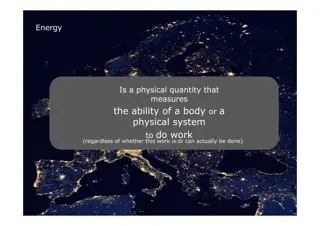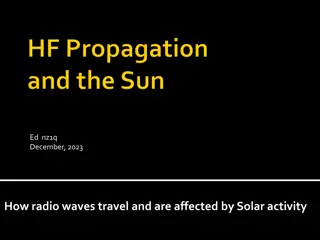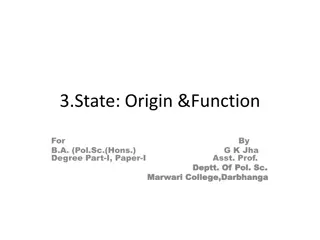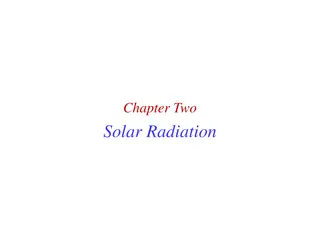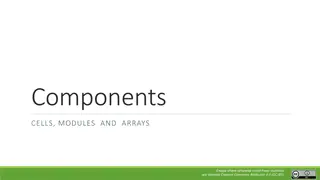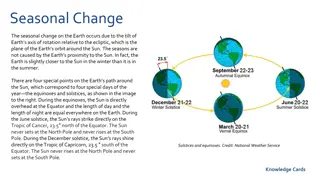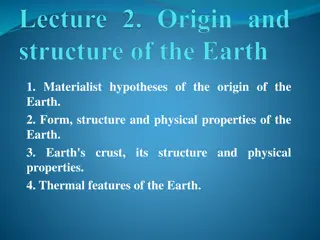Theories on the Origin of Earth and Solar System
Scientists and philosophers have proposed various theories regarding the origin of Earth and our solar system, with concepts ranging from evolutionary to catastrophic. The Dust gas cloud theory, Planetesimal hypothesis, Binary star hypothesis, and more have been suggested to explain how planets were formed. Immanuel Kant's gaseous hypothesis posited that primordial matter collided to create the Earth. Understanding the rotation and revolution of our solar system involves considering factors like gravitational principles and distance between planets.
Download Presentation

Please find below an Image/Link to download the presentation.
The content on the website is provided AS IS for your information and personal use only. It may not be sold, licensed, or shared on other websites without obtaining consent from the author.If you encounter any issues during the download, it is possible that the publisher has removed the file from their server.
You are allowed to download the files provided on this website for personal or commercial use, subject to the condition that they are used lawfully. All files are the property of their respective owners.
The content on the website is provided AS IS for your information and personal use only. It may not be sold, licensed, or shared on other websites without obtaining consent from the author.
E N D
Presentation Transcript
Theories regarding the origin of the earth Various scientist and philosophers have propounded from time to time their concepts, hypotheses and theories to unravel the mystery and to solve the riddle of the problems of the origin and evolution of our solar system in general and of the earth in particular, but none of these could be accepted by majority of the scientific community. Though there is no common argument among the scientist about the origin of our solar system but it can be safely argued that all planets of our solar system are believed to have been formed by the same process.
All the views and concept pertaining to the origin of earth may be divided into two groups. Theoris THEORIES Evolutionary or uniformitarian (Monistic concept) Catastrophic or cataclysmic (Dualistic concept) The Dust gas cloud theory of Dr. weitzesacker s and otto schmidt Planetesimal hypothesis of Chamberlin and Moulton Binary star hypothesis of H.N. Russel and R.A. lyttleton Tidal hypothesis of James jeans and Harold Jeffreys Gaseous mass theory of kant Nebular hypothesis of Laplace The super nova theory of F. HOyle electromagnetic theory of Dr. Hannes Alfven s
Gaseous hypothesis of Immanuel kant -1755 AD Professor Kant was a German (Persia province) citizen. He was a great German philosopher. In 1755 AD Kant claimed that his gaseous hypothesis of the origin of the earth was based on the sound principles of Newton s law of gravitation and rotatory motion. At the time of explaining this theory Kant said that Give me a matter and I will build a world out of it.
The fact that determine the rotation and revolution of the our solar system Distance between planets Two group of planets .. 1) Inner planets 2) Outer planets Fact relating movements are .. 1) Principle of gravitation 2) Principle of inertia 3) Centrifugal force
Some basic fact of kant gaseous hypothesis Kant postulated his gaseous hypothesis of the origin of the earth on a basis of few assumptions. According to kant that a supernaturally created primordial hard matter was scattered in universe. According to kant this matter comprised of very cold, solid and motionless particles. He further assumed that the particles began to collide against each other under their mutual gravitational attractions. This mutual attraction and collision between the particles generated random motion in the primordial matter.
On the basis of number of heavenly bodies involved in the origin of the earth are further divided in to three groups. These are . 1) Monistic concept ( Involving only one heavenly body.) 2) Dualistic concept ( Involving two heavenly bodies) 3) Binary star concept or trihybrid concept ( Involving more than two heavenly bodies)
Collision of the particles also generated friction which generated heat, with the result the temperature of the primordial matter started rising. Thus, the original cold and motionless cloud of matter became in due course a vast hot nebula and started spinning (rotating) around its axis. According to kant with the increase in temperature, the random motion as well as the rate of collision among the particles also increased. The rise in temperature also changed the state of primordial matter from solid to gaseous particles. Thus the initial primordial matter gradually changed in hot rotating nebula. With continuous rise in temperature and rate of rotatory motion the nebula started expanding in size.
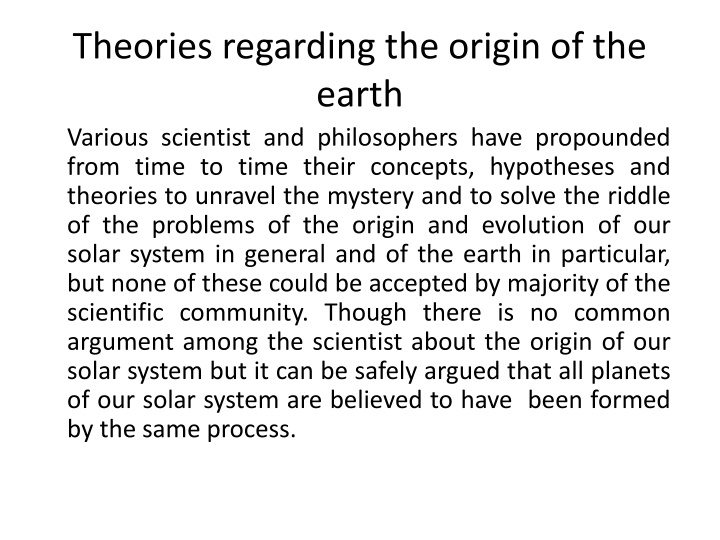


![READ⚡[PDF]✔ The Earth in Context: A Guide to the Solar System (Springer-Praxis S](/thumb/21508/read-pdf-the-earth-in-context-a-guide-to-the-solar-system-springer-praxis-s.jpg)


